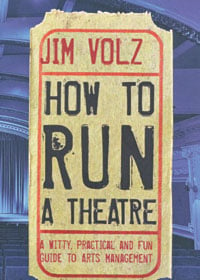Bookshop

How to run a theatre: a witty, practical fun guide to arts management by Jim Volz, Methuen Drama, 2nd Revised edition, 2011 ISBN-10: 1408134748
Jim Volz is an American arts consultant and writer with over 30 years experience as a theatre and arts centre manager. He brings all this vividly to play in this lively and accessible book, which has become a popular easy-to-use and in many ways very practical manual for the teaching of arts management in the States.
Following an unusually comprehensive and user friendly contents section, ‘How to run a Theatre’ opens with a look at ‘Life Management and the Arts’. This consists of a series of homely practical tips on the universal skills of time management, communications, work/life balance and the like which, while often charming, will not always work with more reserved British readers. They could preface any lightweight management tome.
It proceeds with very practical and focussed chapters including executive staff strategic planning (balancing the creative and management sides of the business), working with trustees, personnel management, fundraising, marketing, budgeting and personal skill development. Much of this section is of general practical use and will be of interest to anyone working in the arts. The section on working with trustees in particular contains some useful insights. Volz rounds off with over 20 pages of information on American arts institutions which, without an international context, is of little value to the British reader.
The book is primarily directed at those running producing or touring theatre companies. It is of less specific value than one might expect from its title to those looking for guidance on setting up or running the buildings themselves. As someone who has worked in arts centre management all my life, I learnt much as an outsider looking into someone else’s specialisation, but less of direct value to my area of work. Do not let the English spelling of the word ‘theatre’ on the front cover confuse you: this book is written for those working in the American theater, where management structures, funding and philosophy differ substantially from our own. The style of writing with endless, sometimes repeated lists of dos, don’ts and tips, also jars on this side of the pond and can appear somewhat patronising. Those matters aside, however, the book is very readable and provides a very useful manual for beginners – particularly as it brings together in one place classic strategy formats for planning, fundraising, audience development and budgeting. It is a light read for old hands, and a viable if quirky introductory manual for novices.
Join the Discussion
You must be logged in to post a comment.